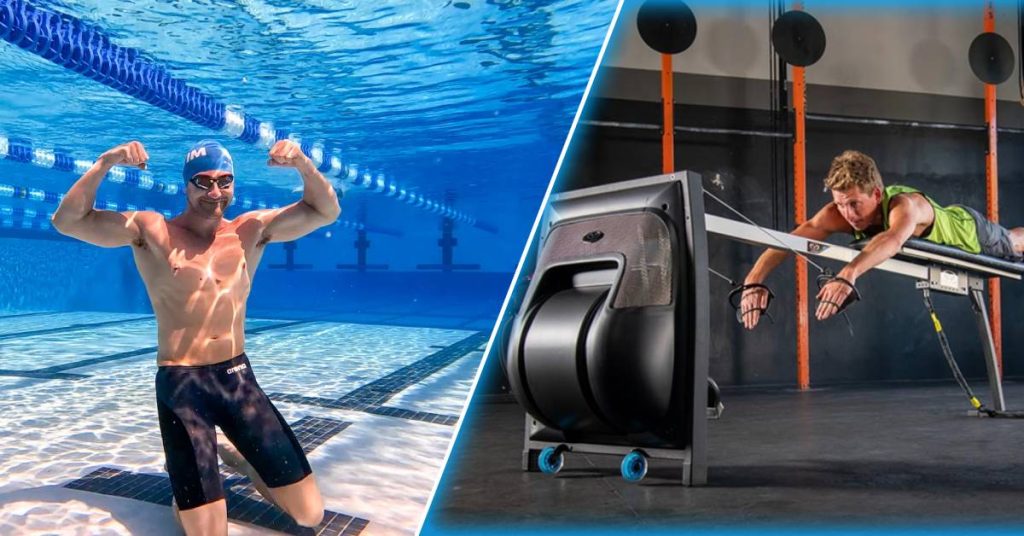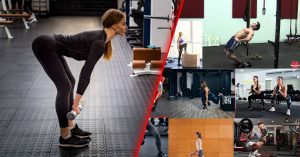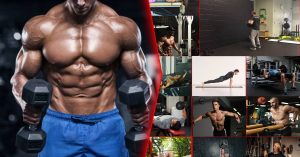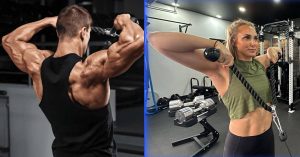Imagine slicing through the water with ease, your strokes more powerful and efficient than ever before. This isn’t just a dream—it’s a reality achievable through targeted gym workouts for swimmers. But how exactly do these workouts transform your performance? The journey from good to great begins with the first step out of the pool and into the gym.
In the dynamic world of competitive swimming and fitness swimming alike, gym workouts for swimmers play a pivotal role. These workouts are not just about building muscle; they’re about enhancing your strength, power, and endurance, improving your technique in the water, and elevating your overall swimming performance to heights you’ve only dreamed of.
Whether you aim to stand atop the podium, with a gold medal around your neck, or you’re swimming for the sheer joy and health benefits it brings, incorporating strength training into your routine is the game-changer you’ve been looking for.
But what makes gym workouts so effective for swimmers? And how can they specifically target the needs of those who spend their time in the water? Read on to find out.
Table of contents
MORE keyboard_double_arrow_down LESS keyboard_double_arrow_up
Building Blocks of Swim Fitness
Swimming is more than just a sport or a way to stay fit; it’s a highly technical and physically demanding discipline that challenges every part of your body. It requires a delicate balance of power, speed, and endurance, a symphony of muscles working in harmony to glide through the water with efficiency and grace.
Traditionally, swimmers have focused primarily on pool workouts to hone their technique and build endurance. However, the landscape of competitive swimming has evolved, with sports science shining a spotlight on the undeniable benefits of gym-based strength training for swimmers.
Integrating specific strength exercises into their training regimen allows swimmers to significantly enhance their power off the blocks, increase their speed through the water, and boost their overall stamina. This can give them a competitive edge that sets them apart from the pack.
But what are these specific exercises, and how do they target the muscles used in swimming? And more importantly, how can you incorporate them into your training regimen without overwhelming your schedule or risking injury? Find out in the next section.
Strength Strategies for Superior Swimming

Let’s dive deeper into the specific gym workouts for swimmers that can make a significant difference in your swimming performance. Each of these exercises is like a piece of a puzzle, fitting together to create a complete picture of strength, speed, and efficiency in the water.
1. Squat Jumps
Squat jumps are the secret sauce to an explosive start and dynamic kicks. They don’t just work your legs; they ignite your entire lower body, creating the power needed to push off the blocks and walls with vigor.
Benefits:
- Increases leg power for starts and turns.
- Improves overall agility and speed.
2. Hanging Crunch
The core is your powerhouse, the central unit that controls your movements, balance, and stability. Hanging crunches are more than just an abdominal workout; they are a critical tool for swimmers seeking to maintain a sleek, streamlined position in the water. A strong core reduces drag, but it also enhances your turns, making them quicker and more efficient.
Benefits:
- Strengthens abdominal muscles.
- Improves posture and stability, reducing drag.
3. Tricep Extension
Your arms are your paddles in the water, and powerful paddles make for powerful strokes. Tricep extensions target these crucial muscles, building the strength needed for each pull and push.
But ensuring you’re performing tricep extensions correctly is paramount; technique matters as much as the effort. Proper form leads to maximum benefit.
Benefits:
- Builds upper arm strength for effective strokes.
- Enhances efficiency and speed in the water.
4. Deadlift
The deadlift is a foundational exercise that targets the back, legs, and core—muscles that are essential for propelling a swimmer through the water. This exercise doesn’t just build muscle; it enhances your overall propulsion and posture, contributing to a more powerful and efficient stroke.
But with the power of the deadlift comes the need for caution and precision in execution. The secret to integrating deadlifts safely into your training regime lies in understanding the correct form and knowing how to adjust the exercise to fit your unique needs as a swimmer.
Benefits:
- Targets key swimming muscles for improved propulsion.
- Enhances posture in the water for more efficient swimming.
5. Shoulder Rotations with Resistance Bands
The journey of a swimmer is often marked by the pursuit of strength and flexibility, especially around the shoulders.
Shoulder rotations with resistance bands are not just exercises; they are the guardians of a swimmer’s health, ensuring the shoulders are not only strong but also flexible and less prone to injuries. Stronger shoulders lead to more powerful strokes, propelling you through the water with increased force.
Benefits:
- Enhances shoulder flexibility and strength.
- Reduces the risk of shoulder injuries.
6. Kneeling Supermans
Balance and core stability are the unsung heroes of a swimmer’s arsenal, often determining the efficiency of every movement in the water. The kneeling superman exercise is a call to action for multiple muscle groups, offering a holistic approach to improving core stability and balance.
This exercise doesn’t just contribute to a swimmer’s efficiency; it redefines it, enabling swimmers to maintain an optimal posture that cuts through water more effectively.
Benefits:
- Improves core stability and balance.
- Targets multiple muscle groups for a comprehensive workout.
7. Overhead Squat
The overhead squat is a testament to the power of balance and leg strength in the world of swimming. By challenging not only your legs but also your core and shoulder stability, this exercise mirrors the multi-dimensional movement of swimming.
The perfection of the overhead squat is more than just an achievement; it’s a transformation, enhancing your ability to maintain balance and strength in the water.
Benefits:
- Enhances leg strength and balance.
- Mimics swimming movements to improve overall performance.
8. Dumbbell Flyes
In the quest for superior swimming performance, chest strength emerges as a critical factor. Dumbbell flyes target this essential area, refining your stroke power and setting you apart in the pool. This exercise isn’t just about building muscle; it’s about sculpting the very tools you need to pull through water more effectively.
Benefits:
- Targets chest muscles to improve stroke power.
- Enhances the effectiveness of your pull in the water.
9. Wide Grip Lat Pull Downs
Wide grip lat pull-downs are not just an exercise; they are a cornerstone for building the upper body strength essential for swimmers. By focusing on the latissimus dorsi muscles, this workout enhances the power behind each stroke, potentially transforming your efficiency and speed in the water. But integrating this exercise effectively requires more than just routine practice.
Benefits:
- Strengthens back muscles, crucial for swimming power.
- Enhances stroke efficiency and speed.
10. Tricep Cable Press
The tricep cable press is a targeted workout designed to fortify the muscles that play a pivotal role in every phase of a swimmer’s stroke. This exercise is about refining the push, ensuring that each movement through the water is as powerful and efficient as possible.
Benefits:
- Focuses on arm strength, especially the triceps.
- Leads to more powerful and efficient strokes.
11. Dumbbell Curls
In the symphony of muscles that orchestrate a swimmer’s stroke, biceps play a critical role during the pulling phase. Dumbbell curls, with their simplicity and effectiveness, are fundamental in building the bicep strength necessary for this action.
But incorporating dumbbell curls into your routine is more than just adding another exercise; it’s about strategically enhancing your pulling power in the water.
Benefits:
- Builds bicep strength for the pulling phase.
- Simple yet effective for enhancing swimming performance.
12. Barbell Military Press
The barbell military press stands out as a comprehensive workout that targets the shoulders and arms, areas of paramount importance for swimmers. This exercise doesn’t just build muscle; it enhances the push-off power and overall stroke efficiency, crucial elements for competitive swimming.
Benefits:
- Strengthens shoulders and arms, critical for swimmers.
- Improves push-off power and stroke efficiency.
13. Pull-Ups
Pull-ups are the ultimate challenge in upper body strength, testing and building the muscles essential for a swimmer’s grip, pull, and overall propulsion through the water. This exercise is about more than just overcoming gravity; it’s about mastering control over your own body to enhance your swimming technique and performance.
Benefits:
- Tests and strengthens arms, shoulders, and back.
- Improves grip and pull in the water, impacting technique and performance.
Strategies for Success: Building a Stronger Swimmer

To tap into the full potential of gym workouts for swimmers, embracing consistency and precision in your approach is essential. Embarking on this journey begins with mastering the technique using lighter weights, laying a solid foundation for your strength training.
As your proficiency grows, so too should the intensity of your workouts, ensuring a gradual and sustainable enhancement of your swimming performance. But integrating these exercises into your swimming routine is an art in itself. How do you weave strength training seamlessly into your schedule, ensuring it complements rather than overwhelms your swim sessions? Here is how:
- Start Small: Begin with foundational exercises to ensure proper form.
- Progress Gradually: Increase intensity and complexity over time.
- Integrate Wisely: Align gym workouts with swimming sessions for optimal recovery and growth.
Demystifying Strength Training: The Truth for Swimmers
The myth that strength training inevitably leads to bulky muscles, potentially hindering a swimmer’s speed and agility, persists among many in the swimming community. However, when approached correctly, strength training for swimmers is a catalyst for enhanced performance.
It bolsters power, speed, and endurance without the addition of unnecessary bulk. The crux of this synergy lies in the balance—strategically incorporating strength training to complement, not compromise, your fluidity and speed in the water.
But how do you strike this delicate balance, ensuring that your strength training regimen builds the right kind of muscle power to boost your swimming performance without sacrificing agility?
- Prioritize exercises that mimic swimming movements.
- Avoid overtraining to prevent excessive muscle gain.
- Allow adequate rest between strength training and swimming sessions.
Expert Tips and Advice
Dr. Genadijus Sokolovas, (Ph.D., CEO of Global Sport Technology, Inc) is a world-renowned expert in sports science and has worked with numerous Olympic swimmers and teams. He emphasizes the importance of incorporating specific strength exercises that target the muscles used in swimming, such as the core, shoulders, back, and legs.
Dr. Sokolovas also stresses the significance of periodization in strength training to ensure proper progression and avoid overtraining.
Keenan Robinson, CSCS, USA Swimming National Team Strength and Conditioning Coach is a Certified Strength and Conditioning Specialist (CSCS) who specializes in working with elite swimmers.
He recommends focusing on exercises that improve power, explosiveness, and stability, such as squats, deadlifts, pull-ups, and medicine ball throws. Robinson also highlights the importance of incorporating dryland training that mimics swimming movements to enhance stroke mechanics and efficiency
Furthermore, the following Instagram post by Jake Tyson a Personal Coach provides some useful tips on strength training for swimmers:
Conclusion
Gym workouts are not merely an addition to a swimmer’s training regimen; they are a transformative force, enhancing strength, power, and endurance. This holistic approach to training doesn’t just prepare the body for the demands of competitive swimming; it redefines what’s possible, pushing the boundaries of performance and endurance.
With the right blend of gym workouts, swimmers can unlock a new level of capability, turning waves into ripples as they glide through the water. The journey from strength training to swimming excellence is one of discipline, dedication, and strategic planning.
So, are you prepared to embark on this journey, to meld the power of the gym with the grace of the pool, and see just how far your newfound strength can propel you?
Key Points
- Gym workouts are crucial for swimmers to enhance their strength, power, and endurance.
- These workouts focus on specific muscle groups used in swimming, leading to better performance in the pool.
- Examples of beneficial exercises include squats, pull-ups, deadlifts, and core exercises.
- Strength training for swimmers aims to improve efficiency and speed, not to bulk up.
- Combining gym and pool training requires strategic planning to avoid overtraining or neglecting important aspects of training.
- Proper execution of exercises in the gym is crucial to maximize benefits and minimize risk of injury.
- Striking a balance between gym and pool training is important for optimal results.
- The specific gym workout plan should be individualized based on the swimmer’s goals, experience, and recovery needs.
FAQs
What gym exercises are good for swimmers?
Mountain climbers are a highly recommended strength training exercise for swimmers as they target the entire body, including shoulders, glutes, triceps, legs, and core. These exercises not only enhance muscle strength but also improve cardiovascular endurance, mirroring the constant movement found in swimming.
Incorporating mountain climbers into your routine can significantly benefit your swimming performance by building overall body strength and stamina.
Can I do swimming and gym together?
Absolutely! Combining swimming and gym workouts on the same day can be incredibly beneficial. Swimming serves as an excellent recovery activity post-gym, helping to alleviate muscle soreness and accelerate recovery times.
This synergy allows swimmers to return to peak performance levels more quickly, making it easier to achieve personal bests in both the pool and the gym.
How many times a week should a swimmer go to the gym?
Swimmers are advised to engage in 2-3 gym sessions per week, each lasting about 30-60 minutes. During the off-season and pre-season, increasing gym time to up to three times a week can be advantageous, allowing for greater focus on strength building.
However, it’s recommended to reduce gym sessions to twice weekly during the competitive season to maintain performance without overtraining.
Why do swimmers go to the gym?
Swimmers go to the gym to develop the power and explosiveness necessary for competitive swimming.
Strength training on land, particularly exercises performed at high speeds or tempos, significantly contributes to a swimmer’s ability to launch off the blocks and push off the pool walls with greater force.
This land-based power training complements pool work, enhancing a swimmer’s speed and overall performance.
Should I swim first or gym first?
The decision on whether to swim or hit the gym first largely depends on personal preference and specific training goals. Some individuals find that swimming first serves as an effective warm-up, preparing the muscles for strength training.
Others prefer starting with gym exercises to build strength and endurance before heading to the pool. Experimenting with both sequences can help determine which order works best for you, optimizing your training outcomes.

ABOUT THE AUTHOR
Follow Valen Steven for a dose of fitness enthusiasm, evidence-based advice, and a roadmap to achieving your health and wellness goals.
Subscribe to our Newsletter
Dive into a world of fitness and wellness with our exclusive newsletter! Sign up now and receive weekly power-packs of fitness wisdom




